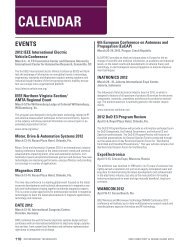© Integran Technologies Inc. 2equilibrium state grain size of around 1‐10µm,the large grain structure must be achievedthrough annealing the metal at hightemperatures, often in a tightly controlledatmosphere to control impurities.Other foils have an amorphous (i.e. nocrystalline grains) or nanocrystalline structurewhich is normally achieved through complexmanufacturing techniques including rapidsolidification and high frequency annealingprocesses.2.2 Existing <strong>Shielding</strong> SolutionsAlthough specialty foils are very effective EMIshields, they are best suited to shielding simplyshaped parts. There are currently a fewmethods for creating parts with relativelycomplex geometries, described in Figure 2 andFigure 3.Figure 2 ‐ Existing <strong>Shielding</strong> Solutions (Part 1).Figure 3 ‐ Existing <strong>Shielding</strong> Solutions (Part 2).2.3 Foil Lay‐up and Formed FoilsSince sheet metal or foils are manufactured flat,materials that resist forming operations, likeglassy amorphous alloys, must be cut to shapeand laid onto flat surfaces in order to achievethe necessary part shielding. Although thesematerials have excellent shielding performance,this lay‐up approach is a cumbersome methodfor shielding parts with any contour or shape.Other less brittle shielding materials can also becut and formed to the shape required. Forexample, a sensitive transducer measuring afaint analog current might require a “can” ofmaterial to be formed to integrate into theenclosure or circuit board for the device. Thisshape would need to be cut and stamped fromthe original sheet metal or foil supply. Althoughthis process adds cost to the shield, it is not, initself, a particularly challenging operation.Unfortunately, the forming operation reducesthe effectiveness of the shield by introducingdeformation into the material – destroying thekey material characteristic that generates thehigh permeability. To restore the defect‐freestructure, the material must be annealed oncemore in the high temperature controlledenvironment to restore shielding effectiveness.
© Integran Technologies Inc. 3This presents a restriction for customers as theforming operation now has to be coupled withan annealing operation, limiting the possiblemanufacturers, or adding an additional step inthe supply chain.Moving away from shielding efficacy, theforming step also sets a practical size limit ascomplex or small geometries are difficult toproduce. As electronic structures andpackaging shrinks, discrete, formed shields maynot be the optimal solution. Lastly, once thediscrete shield is cut, formed, and annealed, itstill needs to be integrated into the assembly ofthe shielded part. This integration requireslabor and often relies on adhesives, furtheradding to the assembly part count, andcomplicating the assembly cost and complexity.2.4 Metal Injection MoldingFine specialty ferromagnetic powders can nowbe injection molded with a binder to createcomplex parts that are effective low frequencymagnetic shields. After molding, the parts arethermally or chemically treated and thensintered at high temperatures where the binderis removed. Secondary operations aresometimes required to achieve the final shape.Although this process can make effectiveshields in relatively complex forms, partshrinkage must be accounted for, as well asmechanical considerations such as part porosity(2%) and brittleness. As tooling costs can behigh, this method is ultimately best suited forhigh volume but relatively small parts.applications where weight is critical, steel isoften being replaced by other materials such aspolymers or aluminum which have little or nolow frequency shielding capability. Thesematerials must often be combined with one ofthe other aforementioned solutions or thedirect part coating solution discussed in thenext section.3. Alternative solution: directCoating of parts withNanovate EMAn alternative solution is to apply a highmagnetic permeability Nanovate EM coatingdirectly to the surface of a part, as shown inFigure 4. This process is more easily adapted tosmall and complex shield shapes and avoidsmany of the possible drawbacks of a discreteshield, including eliminating annealing steps.2.5 Metal ComponentsFinally, conventional metal components canalso be used for low‐frequency EMI shieldingsuch as steel stampings. For many applications,this can be a very cost effective method but theweight addition can be problematic in someapplications. Much thicker steel stock will berequired to achieve the same shieldingeffectiveness as specialty ferromagnetic alloysand in many cases a minimum thickness of steelis required for the forming operations. In manyFigure 4 ‐ Part coated with a Nanovate EM coating.Coating parts with conductive surfaces hasoften been used for high frequency EMIshielding in electronics applications usingtechniques such as PVD, conductive paints, andelectroless and electrolytic plating. In these


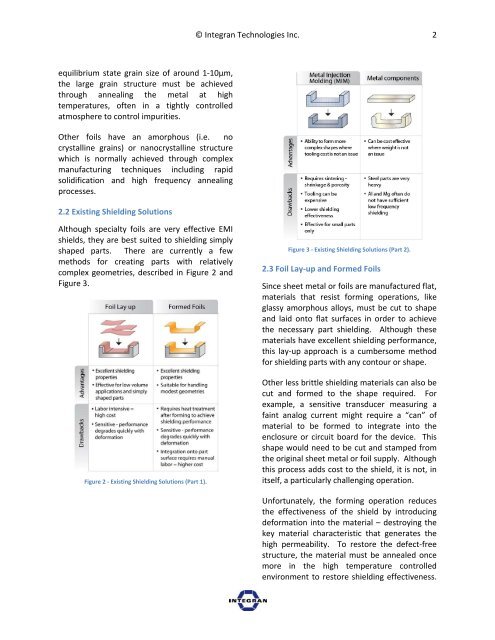


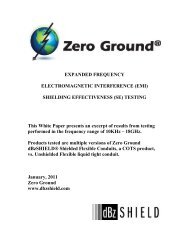
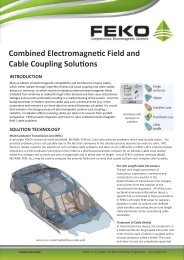

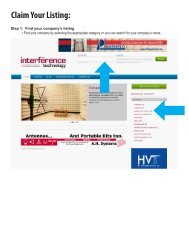
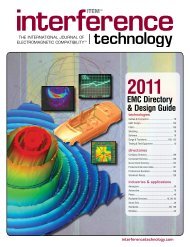

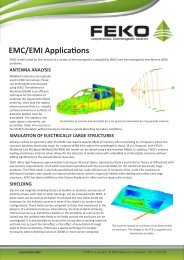
![[ thursday ] morning sessions 8:30 am-noon - Interference Technology](https://img.yumpu.com/23176841/1/190x247/-thursday-morning-sessions-830-am-noon-interference-technology.jpg?quality=85)
